
-
- A
DECADE OF DRINKING: TEN-YEAR TRENDS IN DRINKING PATTERNS IN
AUCKLAND, NEW ZEALAND, 1990-1999
-
- Sally Casswell and Krishna Bhatta
- Alcohol & Public Health Research
Unit, May 2001
- RESULTS
- Changes
in proportions who were drinkers and abstainers
- Frequency
of drinking
- Quantity
consumed on a typical drinking occasion
- Frequency
of drinking larger amounts
- Frequency
of feeling drunk
- Problems
from own drinking
- Problems
from others' drinking
- Concern
about the drinking of others
- Changes
in drinking by the youngest group: 14 - 19 year olds
- Drinking
by age/gender groups
- Aucklanders’ concern over current level of drinking
- Drinkers’
reasons for drinking less
- Drinker’s reasons for drinking more
- Trends
at drinking locations
- Changes
in attitude to and consumption of different beverages
- Home
production of alcohol
- Economic
Influences on Drinking
A
drinker is defined as someone who consumed alcohol in the previous 12 months.
The proportion of the sample (aged 14-65 years) who were drinkers reduced
from 86% in 1990, to 82% in 1996 and returned to 85% in 1999 (Fig 1).
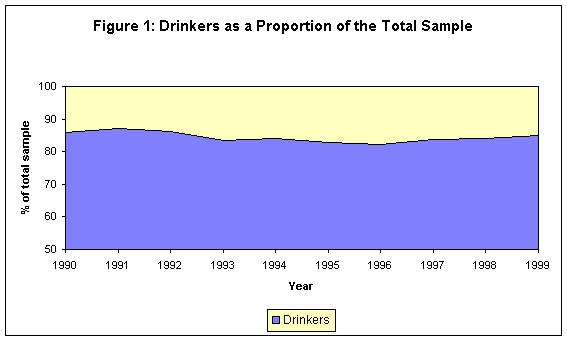
Frequency
of drinking
The
frequency of drinking by the whole sample (excluding abstainers) increased over
the decade. This
increase in drinking frequency was, however, due to the increased percentage of
better educated and higher income people in Auckland.
Once they were taken into account in the analysis there was no increase
in frequency of drinking. There was a drop in drinking frequency from 1990 to
1992 (Fig 2). The
economic circumstances in Auckland in the beginning of the decade were such that
the income of the middle and lower income groups dropped and unemployment
increased. Frequency
of drinking seems to have been affected by the recession in the early 1990s. It
climbed back up to 1990 levels by the middle 1990s, during the period of
economic recovery.
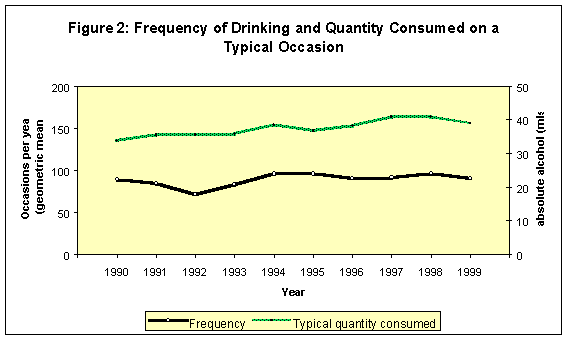
- Quantity
consumed on a typical drinking occasion
-
- As
shown by the top line in figure 2, the quantity consumed on a typical
drinking occasion increased steadily between 1990 (average of 45 mls of
absolute alcohol or 3 drinks) and 1998 (average of 64 mls or 4-5 drinks).
The quantity was increasing even when the frequency of drinking was
declining in the first part of the decade.
-
- Frequency
of drinking larger amounts
- The
frequency of drinking larger amounts (six or more drinks for men and four or
more for women) increased over the decade although there was a decrease
towards the end (Fig 3).
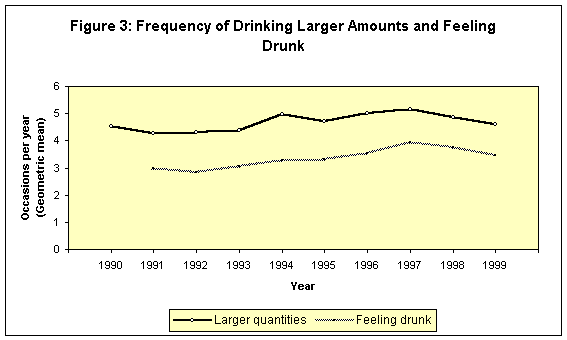
Frequency
of feeling drunk
Respondents
were also asked how often they drank enough to feel drunk (data collected since
1991). These
occasions increased over the decade despite a decline in 1998-1999 (Fig 3).
Problems
from own drinking
Both
the numbers of different types
of problems people experienced and total number of problems they reported
increased over the decade.
Their
reports were based on the 15 specific problem measures which ranged from
relatively minor problems such as hangovers to more serious problems such as
having car crashes and getting into fights (Fig 4).
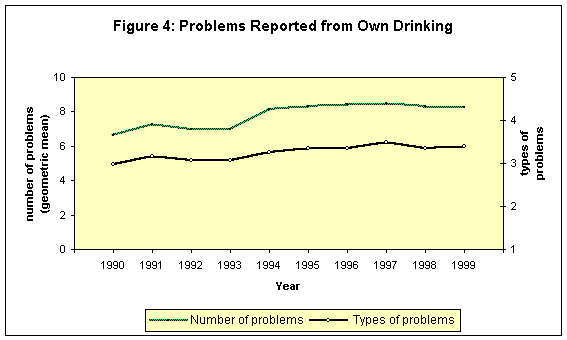
Problems
from others' drinking
People
were asked about the impact of others’ drinking on their lives.
An average of 19% of the sample reported a medium or large level of harm
in at least one of three areas of their lives and this was stable across the
decade.
- The
proportion who had been physically assaulted by a drinker increased slightly
over the decade; 8% reported such an assault in 1999.
There was also a slight increase in reports of sexual harassment over
the decade; 8% reported harassment in 1999 (Fig 5).
This increase was particularly marked among women under 30 from 15%
in 1990 to 20% in 1999.
There were no clear trends in the proportion reporting experiences of
motor vehicle crashes (2.5%), injury or major damage (2.2%) as a result of
other people’s drinking.
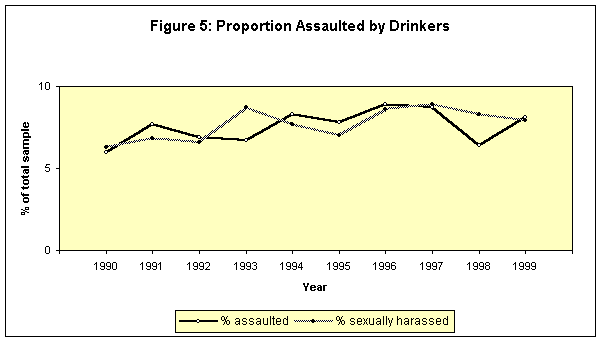
Concern
about the drinking of others
Over
the decade, fewer people said they had been seriously concerned about the
drinking of friends, relatives or acquaintances in the past 12 months (Fig 6).
This was true of both men and women under 30 and of women over 30.
Only the older men showed no change in levels of concern.
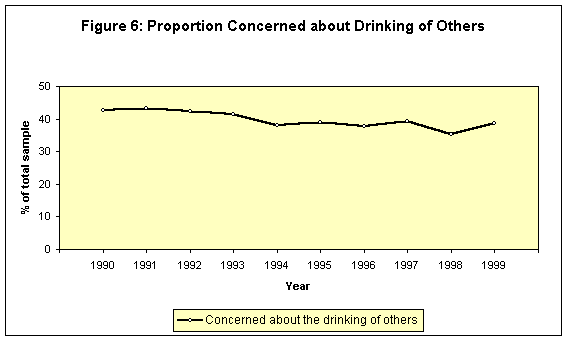
Changes
in drinking by the youngest group: 14 - 19 year olds
The
trend data for 14-19 year old drinkers were based on comparatively small sample
sizes in each survey (about 120 on average). Nevertheless, a number of
significant trends were found.
The proportion of 14-19 year olds (males and females combined) who were
drinkers declined from 82% in 1990, to 66% in 1996, rising back up to 77% in
1999. Figure
7 provides a comparison with the data for 20-65 year olds, for whom there was no
change.
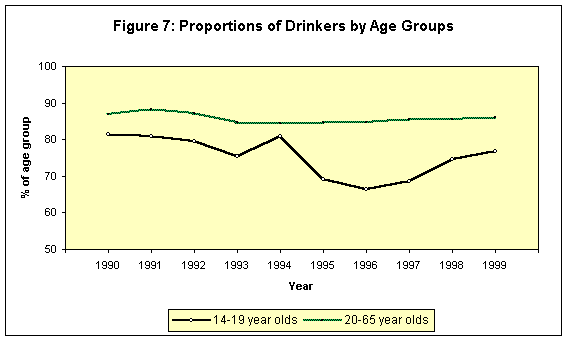
The
frequency of drinking by 14-19 year olds (Fig 8) shows smaller effects from the
economic recession in the first part of the decade than the older drinkers, but
they also increased their drinking frequency during the economic recovery.
That is, an increase in frequency of drinking up to 1996, and a decline
in frequency after 1996.
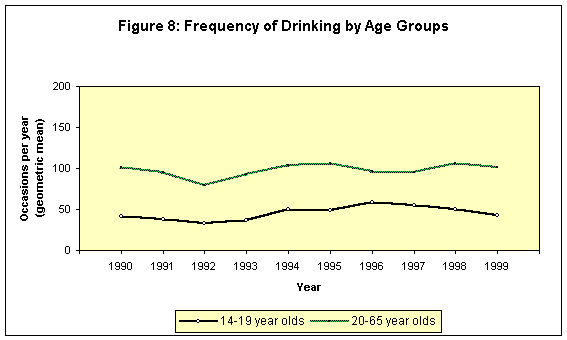
The
quantity consumed on a typical drinking occasion increased more rapidly among
youth drinkers than the older drinkers (Fig 9).
In 1990 14-19 year olds consumed an average of 3-4 drinks on a typical
occasion, whereas in 1999 the average was 5-6 drinks.
This was largely due to increases among the 14-17 year olds whose average
increased from 2-3 to 5-6 drinks.
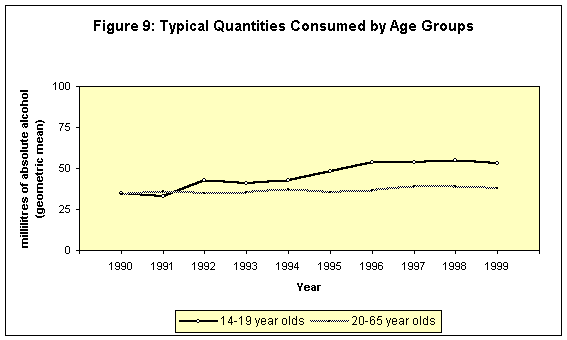
The
frequency of 14-19 year olds drinking larger quantities (6 or more drinks by men
and 4 or more by women) also increased, particularly after 1993 (Fig 10).
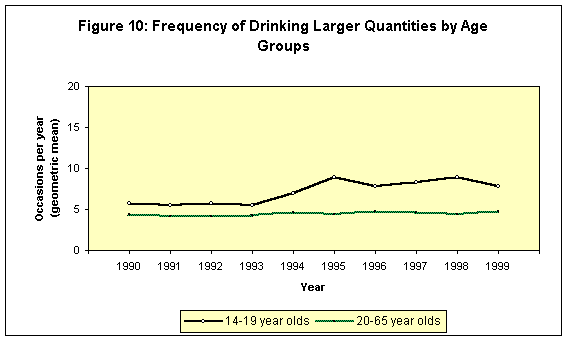
Figure
11 shows that while drinkers of all ages were drinking enough to feel drunk more
frequently in 1999 than they had been in 1992, the increase among 14-19 year
olds was more marked than among older drinkers.
The number of problems experienced by drinkers in the youngest age group
also increased over the decade.
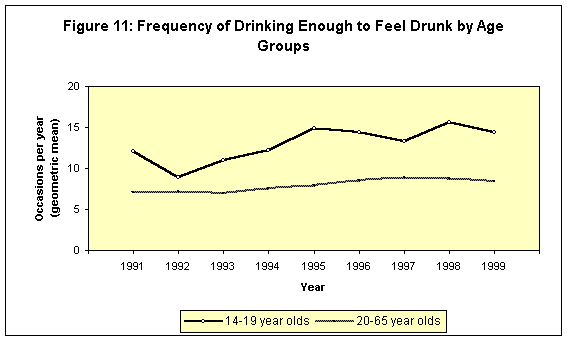
Figure
12 shows the samples of 14 - 19 year olds over the decade in terms of the
percentages who did not drink in the past 12 months (abstainers) and those
drinking various numbers of drinks on a typical drinking occasion.
The data show the increase in the percentage of those drinking 6 or more
drinks (12% in 1990 to 25% in 1999).
It also shows that the proportion of abstainers has fluctuated over the
decade, but that even in times of relatively high abstention the percentage of
the heavier drinkers in this youngest age group was trending upward. This
measure is based on typical drinking quantity (not the question on frequency of
drinking larger amounts.
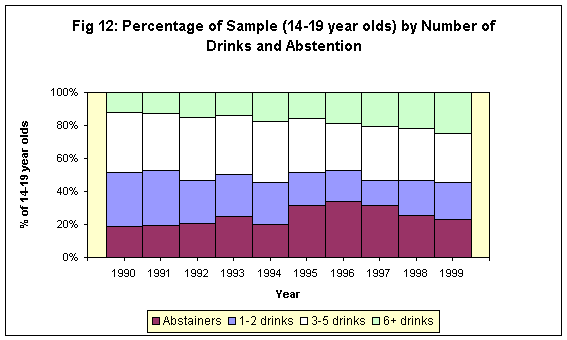
The
survey data has also been analysed to look for different trends in four
demographic groups: men and women under 30 years and men and women 30 and over.
14
to 29 year old men
- The
men under 30 showed some of the same trends as those reported earlier for
the youngest group, the 14-19 year old men and women combined.
This included a decline in the percentage who were drinkers.
Also, among the men under 30, the quantity consumed on a typical
drinking occasion increased from 4-5 drinks in 1990 to 5-6 drinks in 1999.
The frequency of drinking larger amounts (6 drinks or more), the
frequency of feeling drunk and the number of problems also increased.
The frequency of all drinking occasions did not however change among
the group of men under 30.
-
- Figure
13 shows the percentage of younger men drinking different typical quantities
and those who abstained. The
percentage drinking 6 or more drinks on a typical drinking occasion
increased from 21% to 29% over the decade.
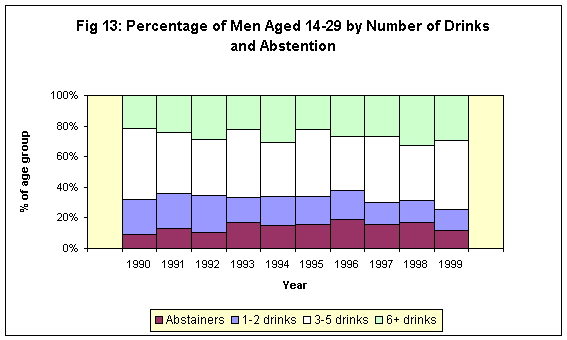
14 to 29 year
old women
- Among
the women under 30, the percentage who were drinkers was stable over the
decade. The typical quantity
consumed increased from 3 drinks in 1990 to 4-5 drinks in 1999.
The frequency of drinking larger amounts, occasions of feeling drunk
and number of problems also increased.
Unlike the men, this group of younger women also showed an increase
in the frequency of drinking. This was not attributable to a change in the educational
status or income of younger women in the sample.
-
- Figure
14 shows the percentage of younger women drinking different typical
quantities and those who abstained. The
percentage drinking 6 or more drinks on a typical drinking occasion for this
group increased from 7% to 14% over the decade.
-
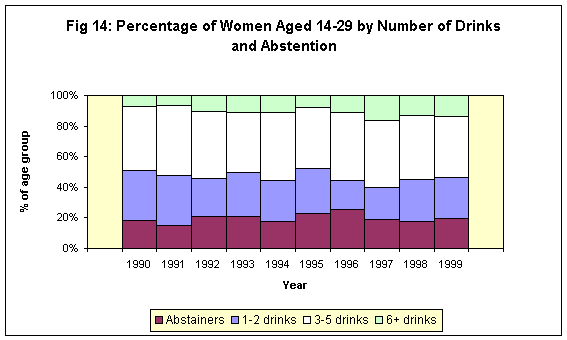
The
women under 30 also reported more sexual harassment by drinkers, which increased
from 15% in 1990 to 20% in 1999.
30 to 65 year
old men
- Among
the men over 30, the proportion who were drinkers was stable.
There were no significant changes among this age group in reporting
of typical quantities consumed (an average of 3-4 drinks on a typical
occasion), frequency of drinking larger amounts (6 or more drinks),
frequency of drunkenness or number of problems resulting from their
drinking. There
was also no increase in the frequency of drinking overall.
-
- Figure
15 shows the percentage of older men drinking different typical quantities
and those who abstained.
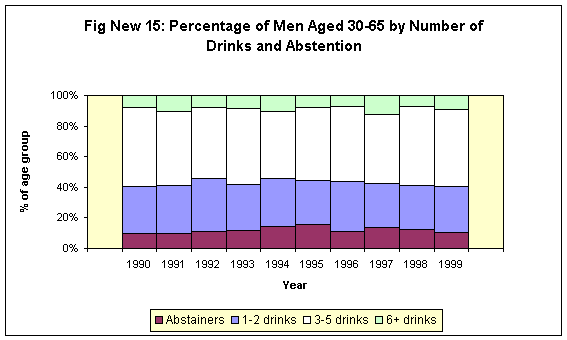
30 to 65 year
old women
- Among
the women over 30 the percentage of drinkers was stable. The quantities that
they consumed on a typical occasion increased, but only slightly, remaining
at approximately 2 drinks throughout the decade.
The frequency of drinking enough to feel drunk and numbers of
problems also increased.
There was no increase in frequency of drinking overall or the
frequency of drinking larger amounts (4 or more drinks) on a drinking
occasion.
-
- Figure
16 shows the percentage of older women drinking different typical quantities
and those who abstained.
The percentage drinking 6 or more drinks on a typical drinking
occasion for this group increased slightly from 1% to 3% over the decade.
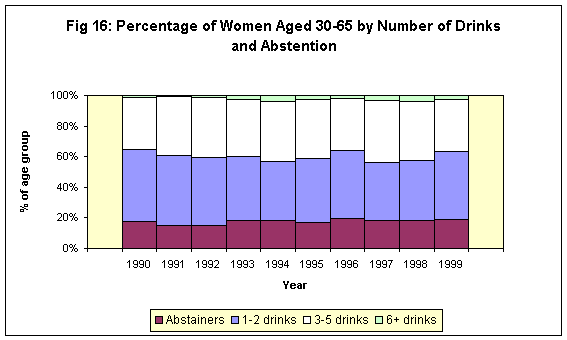
Drinking by
different occupational status groups
Figure
17 shows the percentage of drinkers in the higher and lower occupational groups
(of those in paid employment) over the course of the 1990s.
The lower occupation group includes fewer drinkers and this proportion
decreased over the decade.
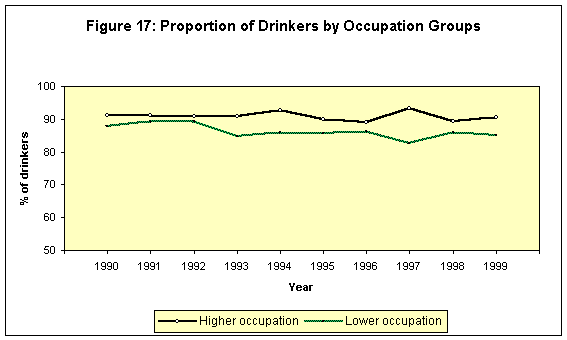
Those
in higher status occupations drank more often but the frequency of drinking
showed no clear trends in either group throughout the decade (Fig 18).
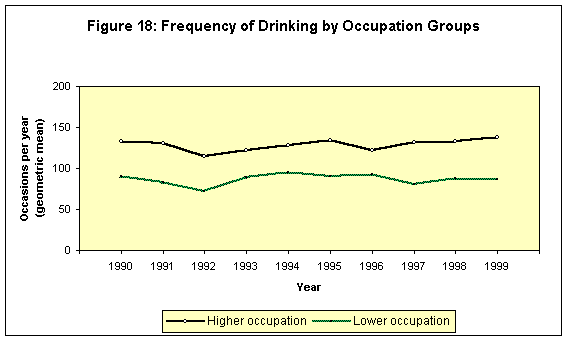
The
lower status occupations, however, consumed more than the higher occupations on
a typical drinking occasion.
For both occupation groups there was an increase in typical quantities
consumed (Fig 19).
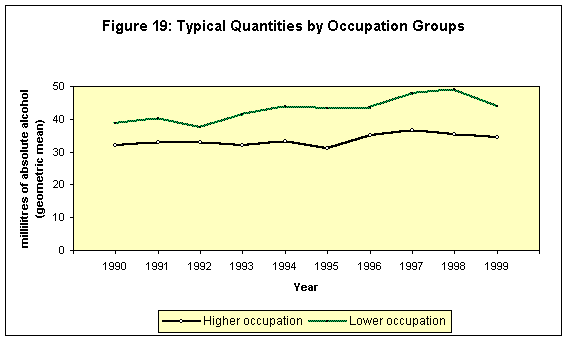
Similarly,
the lower status occupations reported relatively more occasions of ‘drinking
enough to feel drunk’ but the frequency of such occasions have increased for
both the lower and higher status occupations (Fig 20).
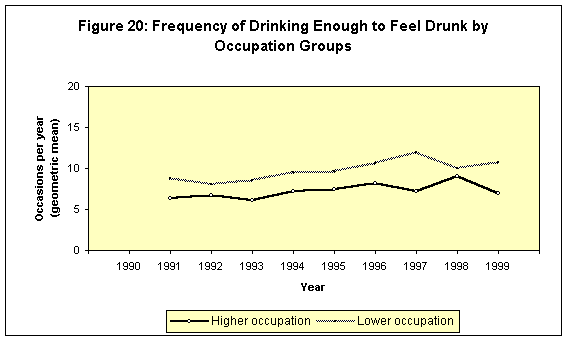
The
number of problems resulting from a respondent’s own drinking was closely
related to typical quantity consumed and frequency of drunkenness, with the
lower status occupations reporting both the highest number of problems and also
an increase (Fig 21).
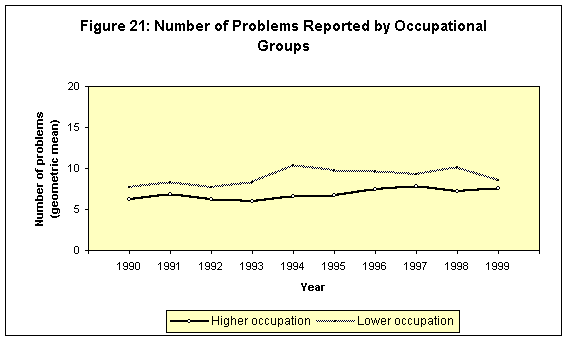
Aucklanders’
concern over current level of drinking
About
15% of the drinkers felt that they were ‘drinking more than they were happy
with’ and this proportion did not change over the decade.
Drinkers’
reasons for drinking less
- Each
year about one third of the respondents said they were drinking less than in
the previous year and there was no change in this over the decade.
For those who reported drinking less, reasons for the change were
surveyed by obtaining responses to a list of possible reasons for drinking
less. The
data showed some changes in the reasons given.
-
- ‘Concern
about being caught drinking and driving’, which was introduced into the
list of possible reasons in 1992, had the highest level of mentions in 1993
- the time of the introduction of compulsory breath testing.
It has shown a significant decline thereafter.
The decline was more pronounced among the under 30 year old men (from
75% in 1993 to 44% in 1999), and under 30 year old women (from 52% to 38%)
(Fig 22).
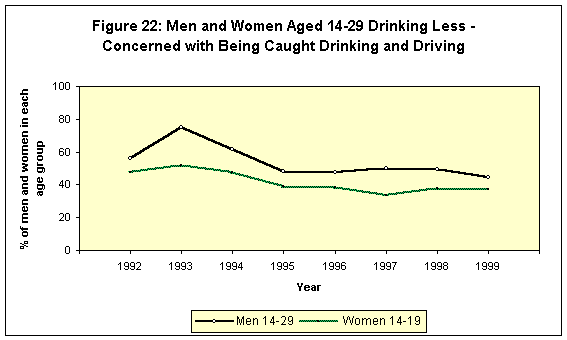
Two
of the offered reasons for drinking less were ‘having less money available to
spend on alcohol’, and ‘alcohol being more expensive’.
The percentage of respondents who gave having less money as a reason
declined over the decade.
This reason was most commonly given in 1991 (41%) and dropped to 23% by
1999. The
percentage of respondents giving ‘alcohol is more expensive now’ as a reason
also declined over this period (Fig 23) (despite a slight increase in the real
price of alcohol over this period, but in keeping with the economic recovery).
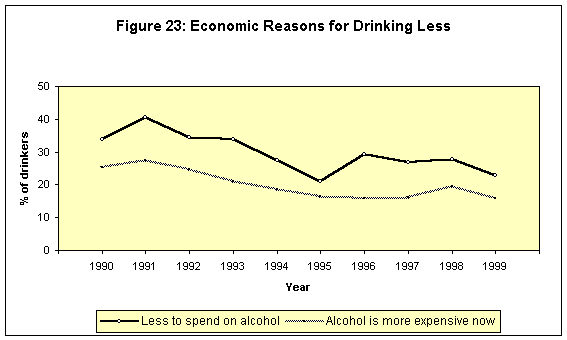
Other
common reasons for drinking less showed no significant change over the surveys.
These included: ‘don’t like to drink and drive’ (70%), ‘concern
about the effects on health’ (53%), ‘want to maintain or increase physical
fitness’ (50%), ‘feel it is generally more acceptable to drink less’
(36%), and ‘limiting drinks for the sake of health’ (35%, introduced into
the surveys 1994).
Drinker’s
reasons for drinking more
About
18% of drinkers each year said they were drinking more than the year before.
There was no change in this level over the decade.
‘Availability of wine in supermarkets’ increased as a reason offered
for drinking more from 4% in 1990 to 13% in 1999.
‘Drinking more wine with meals’ also increased as a reason (24% to
30%) (Fig 24).
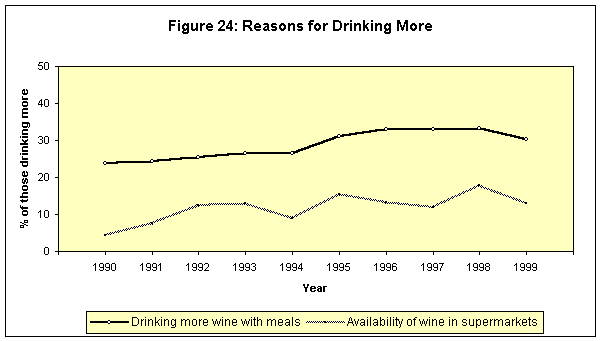
- ‘Because
it is cheaper now’ (5% in 1990 and 15% in 1999) and ‘because it is good
for my health’ (4% in 1990 and 12% 1999) also increased over time as
reasons for drinking more.
-
- Popular
reasons for drinking more that did not show significant changes included:
‘alcohol now served at more of social occasions I attend’ (47%), ‘now
more acceptable to drink alcohol in a wide range of places’ (29%),
‘drinking more wine at times other than meals’ (21%), ‘there are so
many places serving alcohol that I enjoy drinking at’ (23%, introduced to
the survey in 1994), ‘problems and stress in life’ (19%), and ‘range
of places selling takeaway alcohol makes it easier to buy’ (19%,
introduced in 1994). Other
reasons relevant to policy changes and which showed no change were ‘more
licensed places where I can go to have a drink’ (12%); ‘more places that
serve alcohol are open longer’ (15%, introduced 1994); ‘range of places
selling takeaway alcohol makes it easier to buy’ (13%, introduced 1994);
‘takeaway alcohol more available when supplies have run out’ (15%,
introduced 1994).
Trends
at drinking locations
- Over
the decade a number of changes occurred in the popularity of drinking
locations, either because more people drank there, or because people drank
there more often. The typical
quantities reported for different locations also changed over time.
-
- Drinking
in one’s own home, already a common location, increased slightly in
popularity from 90 % in 1990 to 91% in 1999. There was also an increase in
the typical quantities drunk there from approximately 3 drinks per occasion
in 1990 to between 3 and 4 drinks in 1999.
-
- Other
people’s homes were also a common venue for drinking. While the percentage of people drinking there did not change
from its level of around 88% over the decade, people drank there more often
and also drank larger amounts.
-
- There
were also changes in drinking on licensed premises. Increasing numbers of people drank in pubs and in nightclubs.
They also drank there more frequently and consumed larger quantities.
The percentage of people drinking in restaurants remained stable but
people drank there more frequently as well.
People also drank more often at cafes, which became available as
places to drink after the changes to the 1989 Sale of Liquor Act, and
increased in popularity from the mid 1990s on (from 8% in 1990 to 16% in
1999). However, the quantities consumed decreased in both restaurants and
cafes.
-
- Changes
in the Sale of Liquor Act 1989 have also been reflected in drinking on
domestic flights. The
proportion of people drinking on plane trips within New Zealand has
increased from 3% in 1990, when it first became possible, to 14% in 1999
(Fig 25). The frequency of drinking also increased as did the typical
quantities consumed.
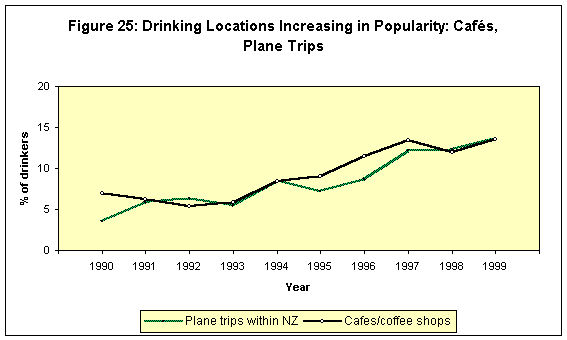
- The
percentage of people drinking in private motor vehicles, while small,
increased from 4% in 1990 to 6% in 1999.
Drinking in outdoor public places increased slightly over the decade.
In neither place did people drink there more often, but typical
quantities increased in outdoor public places from 52mls in 1990 to 56mls in
1999.
-
- Sports
clubs decreased in popularity as drinking locations (from 25% in 1990 to 22%
in 1999) and those drinking there did so less often. The typical quantities consumed remained stable (an average
of 4 drinks). People also drank
less often at sports events and at clubs such as RSA and Rotary. Workplaces were another venue in which people drank less
often (41% in 1990 and 36% in 1999).
-
- The
trends in popularity and patterns of drinking in particular locations
differed between age and gender groups.
-
- Increased
numbers of men under 30 (whose consumption has increased over the decade)
drank in nightclubs and fewer drank in restaurants and workplaces.
They drank more often in other people’s homes, nightclubs, and
restaurants. There was an
increase in the quantities they typically consumed in their own homes, at
other people’s homes, nightclubs and in outdoor public places.
The only decreases in frequency of drinking in this group was in
sports clubs and the only venue in which typical quantities decreased was
restaurants.
-
- More
women under 30 drank in nightclubs by the end of the decade and fewer drank
in sportsclubs. They drank more often in nightclubs, restaurants, pubs, and
at home. Their typical
quantities consumed at home, in nightclubs and pubs, and also in other
people’s homes all increased but the quantities drunk in restaurants by
this group decreased.
-
- Older
men (30 and over) did not show increases in frequency or quantity of
drinking overall but more of them drank in pubs, nightclubs, restaurants and
on aeroplanes. They drank more
often in pubs and restaurants. Fewer
drank in sports clubs and they drank less often in workplaces and clubs such
as RSA and Rotary. The typical
quantities consumed in their own homes and on aeroplanes, increased but
decreased in sports clubs and in restaurants.
-
- Among
women 30 and over, more of them drank in pubs.
They drank more often in restaurants and pubs, and less often in
sports clubs, at sports events and outdoors.
Typical quantities increased in pubs, their own homes, at other’s
homes, at sports events and on domestic flights.
-
- Of
the group whose overall drinking showed the most marked increases (those
aged 14 – 19), more drank in outdoor public places, and fewer of them
drank in nightclubs and restaurants. They
drank more often in their own homes and in other people’s homes.
Figure 26 illustrates the increases in typical amounts drunk by the
14 – 19 year olds in the sample, in someone else’s home.
This contrasts with the much smaller increase among the other age
groups. The average number of
drinks consumed on a typical drinking occasion in someone else’s home by
this youngest group increased from 3-4 drinks in 1990 to 4-5 drinks in 1999.
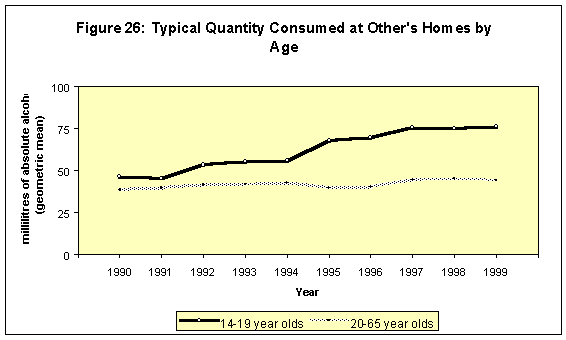
Increases
in typical amounts consumed by the 14–19 year olds also occurred in
nightclubs, at home, in outdoor public places and in cars.
There was a marked increase in typical quantities consumed in nightclubs,
particularly after 1994 when they rose to an average of 6-7 drinks on a typical
visit in 1997, but have since declined (Fig 27).
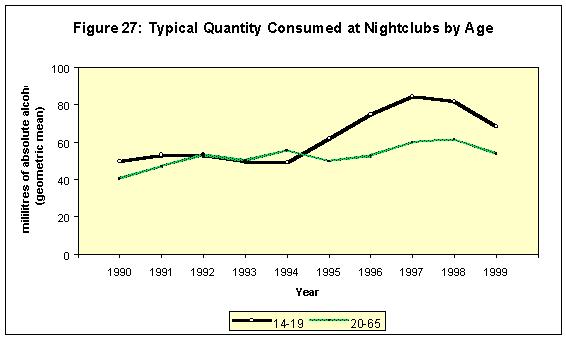
Other
locations in which the youngest drinkers reported fairly high typical quantities
but without change over time were pubs: (5-6 drinks on a typical occasion),
sportsclubs (4-5 drinks on a typical occasion) and sports events (4-5 drinks on
a typical occasion).
Changes
in attitude to and consumption of different beverages
- Over
the decade there was an increase in the proportion of beer drinkers saying
they were drinking less beer, both full strength and low alcohol, from 33%
in 1990 to 38% in 1999. This
was consistent with the decline in beer available for consumption (from
Statistics NZ data) that occurred in New Zealand over this period.
- Consumption
of low alcohol beer was measured since 1993 and the proportions saying they
were drinking more low alcohol beer decreased from 28% in 1993 to 10% in
1996. The data on low alcohol
beer available for consumption from Statistics NZ is consistent with this
decline.
- Among
wine drinkers there was also an increase in those who said that they were
drinking more wine than in the previous year.
This trend is consistent with national data on wine available for
consumption in New Zealand.
-
- Respondents
were asked whether different alcoholic beverages were a suitable drink for
most times of the day. Over the
decade there was increased agreement that wine is a suitable drink for most
times of the day (Fig 28). This
trend was stronger among women over 30, but was also apparent among men over
30. There was no significant
change in support for either beer or spirits as a suitable drink for most
times of the day. The
acceptability of wine has now reached that of beer.
Almost one in three respondents think that wine and beer is
appropriate at most times of the day.
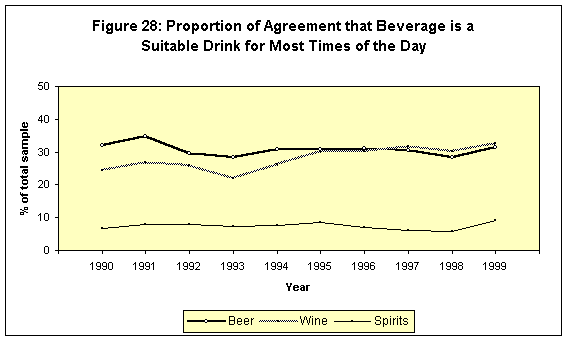
Home
production of alcohol
The
production of home brewed beer was monitored in surveys in 1990 and from 1993 to
1999. There
was a decrease in the proportion of people who brewed their own beer in the
previous 12 months, from 5% in 1990 to 2% in 1999.
The proportion of those who had made up new batches at least 4 to 6 times
a year decreased from 3% in 1990 to less than 1% in 1996 (Fig 29).
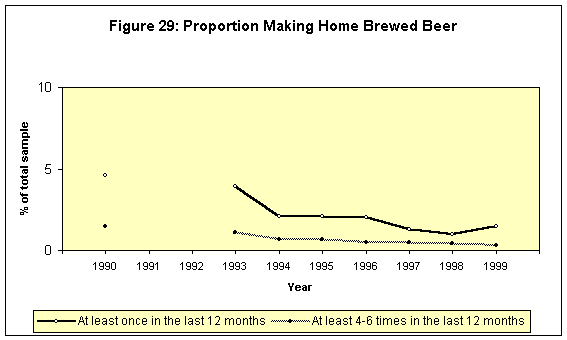
Economic
Influences on Drinking
Figure
30 shows that the higher the income, the more likely a respondent is to be a
drinker. The highest income group
had the highest percentage of drinkers and this proportion did not vary in the
ten years between 1990 and 1999. The
changing economic circumstances in the early 1990s were reflected in the
percentage of the middle income group who were drinkers.
The lower income group had the lowest proportion of drinkers, and this
proportion did change over time. The
proportion of drinkers fell from 79% in 1990, to 70% in 1996.
The proportion then rose to 78% in 1999.
It appears therefore that both the middle and lower income groups
responded to the decline in their real incomes in the first part of the decade
by more people not having anything to drink.
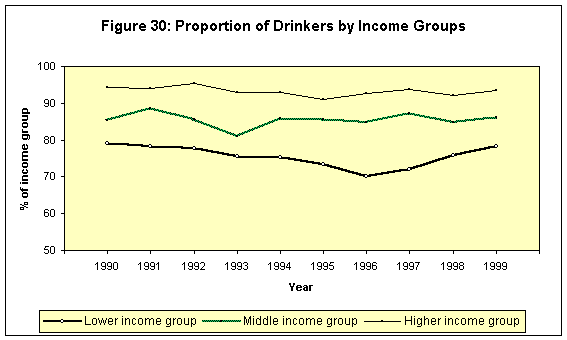
Figure
31 shows that income and frequency of drinking are also related.
The higher the income, the more frequently alcohol was consumed.
Furthermore, Figure 31 suggests that the change in frequency of drinking,
particularly the higher and middle income groups, followed the decline in their
average incomes in the economic recession of the early 1990s.
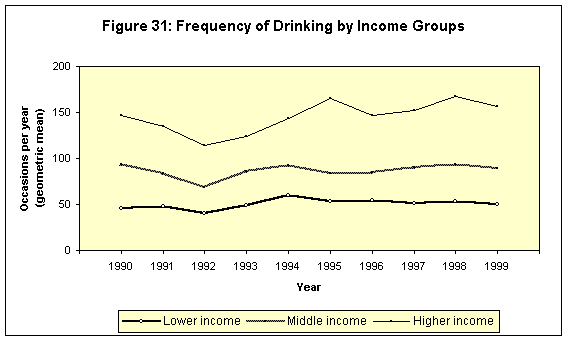
- Quantity
of drinking shows a different relationship with income compared with
frequency, with much less difference between the different income groups
(Fig 32).
-
- All
groups slightly increased their consumption over the decade.
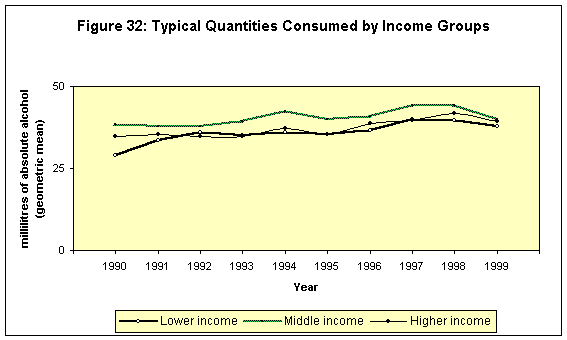
All
of the income groups had experienced an increase in both the frequency of
drinking enough to feel drunk and the number of problems experienced (Fig 33).
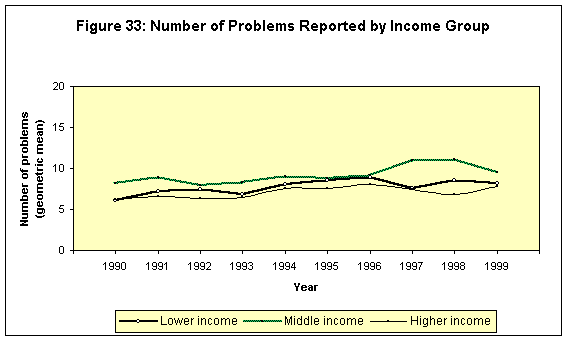
Top
| Back | Next | Home
































